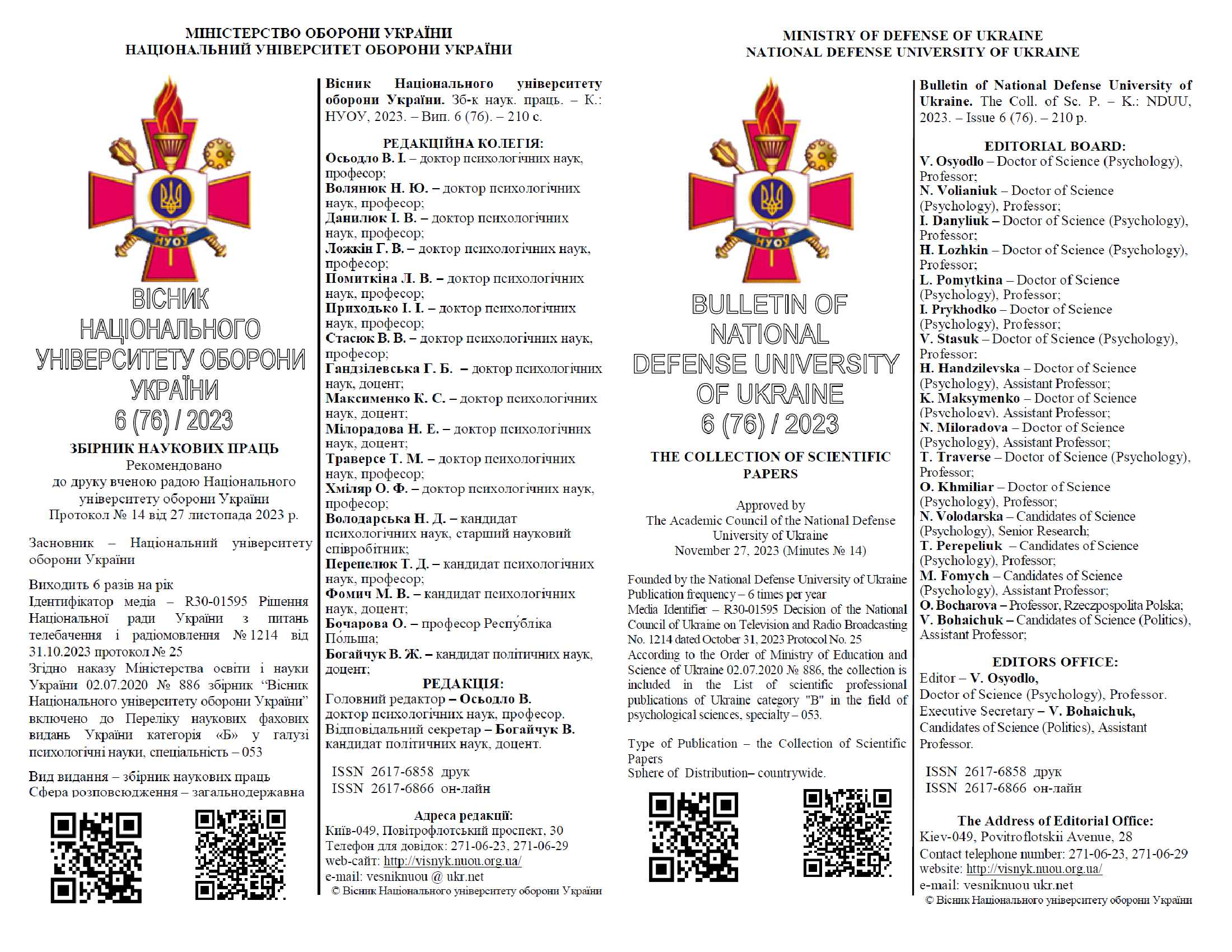ЮНАЦЬКА АГРЕСИВНІСТЬ В НЕВИЗНАЧЕНОМУ СЬОГОДЕННІ
DOI:
https://doi.org/10.33099/2617-6858-2023-76-6-19-28Ключові слова:
агресія, тривожність, рання юність, психологічний захист, особистісна тривожність, ситуаційна тривожність, негативізм.Анотація
У статті представлені результати дослідження агресивних проявів у ранній юності. Не виявлено суттєвих відмінностей між хлопцями та дівчатами у формах прояву агресії, що є наслідком зміщення соціальних ролей. Діагностовано додатну кореляцію ситуаційної тривожності з «підозрілістю», спричиненою загостреним у ранній юності почуттям справедливості, та особистісної тривожності з негативізмом – формою психозахисту на шляху до самоствердження. Вказано на необхідності дослідження агресивності як механізму психологічного захисту в ранній юності.
Завантаження
Посилання
Halian, I. (2011). Psykhodiahnostyka [Psychodiagnosis]. Kyyiv: Akademvydav. (in Ukrainian)
Halian, O. (1999). Spivvidnoshennya imperatyvnosti ta dialohichnosti u stylʹoviy kharakterystytsi diyalʹnosti vchytelya [Correlation of imperativeness and dialogicity in the stylistic characteristics of the teacher's activity]. (Dys. kand. psykhol. nauk). Instytut psykholohiyi imeni H.S.Kostyuka APN Ukrayiny. Kyyiv. (in Ukrainian)
Halian, O., & Halian, I. (2000). Ahresyvnistʹ yak osobystisnyy chynnyk diyalʹnosti vchytelya [Aggressiveness as a personal factor in the teacher's activity]. Psykholohiya, 9(2), 222-227. (in Ukrainian)
Drozdov, O. (2003). Sotsialʹno-psykholohichni faktory dynamiky ahresyvnoyi povedinky molodi [Socio-psychological factors of dynamics of aggressive behavior of young people]. (Dys. kand. psykhol. nauk). Chernihivsʹkyy derzhavnyy pedahohichnyy universytet imeni T.H.Shevchenka. Chernihiv. (in Ukrainian)
Serheyeva, K. (2015). Ukrayinsʹkyy dosvid vprovadzhennya prohram profilaktyky ahresyvnoyi povedinky pidlitkiv u tsentrakh sotsialʹno-psykholohichnoyi reabilitatsiyi [Ukrainian experience of implementation of programs for the prevention of aggressive behavior of adolescents in social and psychological rehabilitation centers]. Pedahohichni nauky: teoriya, istoriya, innovatsiyni tekhnolohiyi, 8(52), V, 403-410. (in Ukrainian)
Sprynsʹka, Z. (2009). Spivvidnoshennya ahresyvnoyi povedinky ta tsinnisnykh oriyentatsiy osobystosti [Correlation of aggressive behavior and value orientations of the individual]. (Dys. kand. psykhol. nauk). Pivdennoukrayinsʹkyy derzhavnyy pedahohichnyy universytet imeni K.D.Ushynsʹkoho. Odesa. (in Ukrainian)
Abler, B., Walter, H., & Erk, S. (2005). Neural correlates of frustration. Neuroreport, 16(7), 669-672. DOI: 10.1097/00001756-200505120-00003.
Bandura, A. (2016). Moral disengagement: how people do harm and live with themselvesy. New York: Macmillan.
Barker, E.D., Tremblay, R.E., Nagin, D.S., Vitaro, F., & Lacourse, E. (2006). Development of male proactive and reactive physical aggression during adolescence. Journal of Child Psychology and Psychiatry, 47(8), 783-790. DOI: 10.1111/j.1469-7610.2005.01585.x
Berkowitz, L. (1993). Aggression: its causes, consequences, and control. New York, McGraw-Hill.
Buss, A.H. (1961). The psychology of aggression. New York, London: John Wiley.
Buss, A.H., & Durkee, A. (1957). An inventory for assessing different kinds of hostility. Journal of Consulting Psychology, 21, 343-349.
Buss, A.H., & Durkee, M. (1957). The buss-durkee hostility inventory. Palo Alto, CA: Consulting Psychologists Press. URL: https://scales.arabpsychology.com/s/buss-durkee-hostility-inventory-bdhi/
Caprara, G.V., Gargaro, T., Pastorelli, C., Prezza, M., Renzi, P., & Zelli, A. (1987). Individual differences and measures of aggression in laboratory studies. Personality and Individual Differences, 8, 885-893.
Dollard, J.L., Miller, D.G. (1939). Frustration and aggression. New Haven: Yale University.
Eysenck, H.J. (1970). The structure of human specialty (Renaissance of psychology). Routledge. London.
Fromm, E. (2015). Anatomie der menschlichen destruktivität / Aus dem englischen von L. Mickel und E. Mickel. Hamburg: Rowohlt-Verlag.
Halian, I., Kurova, A., Skliaruk, A., Halian, O., & Khokhlov, A. (2022). Estabilidad emocional como factor del bienestar psicológico de futuros especialistas. Amazonia Investiga, 11(51), 183-196. https://doi.org/10.34069/AI/2022.51.03.17
Jung, C.G. (2002). Psychology of the unconscious. Edinburg: Dover Publications (originally 1916).
Lorenc, К. (1963). Das zogenannte bose: zur naturgeschichte der aggression. Wienn: Viene Methuen.
McCarthy-Tucker, S., Gold, A., & Garcia, E. (1999). Effects of anger management training on aggressive behavior in adolescent boys. Journal of Offender Rehabilitation, 29(3-4), 129-141. DOI: 10.1300/J076v29n03_07
Scott, B.G., Lapré, G.E., Marsee, M.A., & Weems, C.F. (2014). Aggressive Behavior and Its Associations With Posttraumatic Stress and Academic Achievement Following a Natural Disaster. Journal of Clinical Child & Adolescent Psychology, 43(1), 43-50. DOI: 10.1080/15374416.2013.807733
Spielberger, C.D. (1989). State-trait anxiety inventory: bibliography (2nd ed.). Palo Alto, CA: Consulting Psychologists Press.
Spielberger, C.D., Gorsuch, R.L., Lushene, R., Vagg, P.R., & Jacobs, G.A. (1983). Manual for the state-trait anxiety inventory. Palo Alto, CA: Consulting Psychologists Press.
Tangney, J.P., Wagner, P., Fletcher, C., & Gramzow, R. (1992). Shamed into anger? The relation of shame and guilt to anger and self-reported aggression. Journal of Personality and Social Psychology, 62(4), 669-675.
Werner, N.E. (2012). Do hostile attribution biases in children and parents predict relationally aggressive behavior? The Journal of Genetic Psychology, 173(3), 221-245.
Wiggins, J.S., & Trapnell, P. (1996). A dyadic-interactional perspective on the Fife-Factor model. In: J.S. Wiggins (Ed.). The Five-Factor model of personality (pp.88-162). New York: Guilford.
Zhang, Y., Shi, P., Gao, M. & Chang, H. (2022). Factors influencing aggressive adolescent behavior: an analysis using the Decision Tree method. The Journal of Genetic Psychology, 183(6), 537-548. DOI: 10.1080/00221325.2022.2094213
Zuckerman, M., Kuhlman, D.M., Joireman, J.A., Teta, P., & Kraft, M. (1993). A comparison of Three Structural Models for Personality: The Big Three, the Big Five, and the Alternative Five. Journal of Personality and Social Psychology, 65, 757-768.
##submission.downloads##
Опубліковано
Як цитувати
Номер
Розділ
Ліцензія
Авторське право (c) 2023 Вісник Національного університету оборони України

Ця робота ліцензується відповідно до Creative Commons Attribution-NonCommercial-ShareAlike 4.0 International License.





